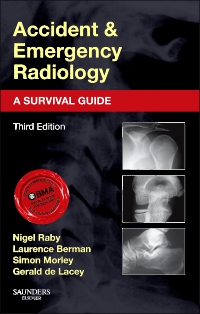
Accident and Emergency Radiology: A Survival Guide, 3rd Edition
Paperback

Now $51.84
Since it was first published, Accident and Emergency Radiology: A Survival Guide has become the classic in-my-pocket-reference and an indispensable aid to all those who work in the Emergency Department. The core and substantial value lies in the step-by-step analytical approaches which help you to answer this question: "These images look normal to me, but . . . how can I be sure that I am not missing a subtle but important abnormality?"
"This book will provide essential reading and support to A&E trainees, medical students, radiology trainees, reporting radiographers and clinical nurse specialists, all of whom may be faced with trauma cases requiring accurate diagnosis and treatment." Reviewed by: RAD Magazine Feb 2015
"... Very nearly flawless...contains just the right amount of information to accommodate readers from trainees through to consultant or attending level." Reviewed by African Journal of Emergency Medicine , Jun 2015
-
- Ensure accuracy in reading and interpretation of any given image. Common sources of error and diagnostic difficulty are highlighted.
- Prevent mistakes. Pitfalls and associated abnormalities are emphasized throughout.
- Avoid misdiagnoses. Normal anatomy is outlined alongside schemes for detecting variants of the norm. Each chapter concludes with a summary of key points. Will provide a useful overview of the most important features in diagnosis and interpretation.
- Easily grasp difficult anatomical concepts. Radiographs accompanied by clear, explanatory line-drawings.
-
- Spend less time searching with an improved layout and design with succinct, easy-to-follow text. A templated chapter approach helps you access key information quickly. Each chapter includes key points summary, basic radiographs, normal anatomy, guidance on analyzing the radiographs, common injuries, rare but important injuries, pitfalls, regularly overlooked injuries, examples, and references.
- Grasp the nuances of key diagnostic details. Updated and expanded information, new radiographs, and new explanatory line drawings reinforce the book’s aim of providing clear, practical advice in diagnosis.
- Avoid pitfalls in the detection of abnormalities that are most commonly overlooked or misinterpreted.
- Access the complete contents and illustrations online at Expert Consult—fully searchable!
-
Basic Principles
Skull
Face
Shoulder
Elbow
Wrist and Distal Forearm
Hand and Fingers
Cervical Spine
Thoracic and Lumbar Spine
Pelvis
Hip and Proximal Femur
Knee
Ankle and Hindfoot
Midfoor and Forefoot
Chest
Abdomen
Penetrating Foreign Bodies
Swallowed Foreign Bodies
Particular Paediatric Points
Glossary

 as described in our
as described in our 